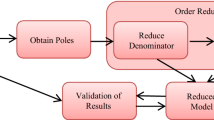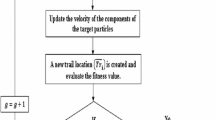Abstract
Reducing the order of a system from higher to lower one is termed as model order reduction (MOR). Usual numerical algorithms are available to get reduced order model from higher order system. In this paper, the higher order associated with the system is reduced to lower one with the help of different methods. The pole clustering algorithm to develop an approximation for a stable higher order system is presented. In proposed method, denominator coefficients of reduced order model are obtained by improved pole clustering, and numerator coefficients are determined by Pade approximation technique. The second method introduced is differentiation technique, in which denominator coefficients of the reduced order model are obtained by means of differentiation technique and numerator coefficients are obtained by Routh approximation method. The genetic algorithm (GA) is also exposed in reducing the order. GA based on minimization of the integral-squared error (ISE) pertaining to a unit step input is introduced. The algorithm presented is simple and computer oriented. The reduced order model retains the stability of the system if the original higher order system is stable. A test system is given to demonstrate the superiority of order reduction by GA over some existing methods. The proposed methods are compared based on step response specifications, Bode response specifications and ISE.
Access this chapter
Tax calculation will be finalised at checkout
Purchases are for personal use only
Similar content being viewed by others
References
Singh SP, Singh V, Singh VP (2019) Analytic hierarchy process based approximation of high-order continuous systems using TLBO algorithm. Int J Dynam Control 7(1):53–60
Singh VP, Chauhan DPS, Singh SP, Prakash T (2017) On time moments and Markov parameters of continuous interval systems. J Circuits, Syst Comput 26(3):1750038
Singh VP, Chandra D (2012) Model reduction of discrete interval system using clustering of poles. Int J Model Ident Control 17(2):116–123
Singh VP, Chandra D (2012) Analysis and adjustment of steady state response of rational systems associated with interval systems. In: IEEE students conference on engineering and systems (SCES), Motilal Nehru National Institute of Technology, Allahabad, India. https://doi.org/10.1109/sces.2012.6199081
Singh VP, Chaubey P, Chandra D (2012) Model order reduction of continuous time systems using pole clustering and Chebyshev polynomials. In: IEEE students conference on engineering and systems (SCES), Motilal Nehru National Institute of Technology, Allahabad, India. https://doi.org/10.1109/sces.2012.6199028
Singh VP, Chandra D, Singh SP, Pandey SK (2011) Reduction of discrete interval system using clustering of poles with Pade approximation: a computer-aided approach. In: National conference on emerging trends in electrical and electronics engineering (ETEEE), Kamla Nahru Institute of Technology, Sultanpur, India
Singh VP, Chandra D (2011) Model reduction of discrete interval system using dominant poles retention and direct series expansion method, IEEE International power engineering and optimization conference (PEOCO), Grand Blue Wave Hotel, Shah Alam, Malaysia. https://doi.org/10.1109/peoco.2011.5970421
Sinha AK, Pal J (1990) Simulation based reduced order modeling using a clustering technique. Comput Electr Eng 16(3):159–169
Pade H (1892) Sur La representation approaches dune function pardes fraction vationnellers 9, pp 1–32
Panda S, Tomar SK, Prasad R, Ardil C (2009) Reduction of linear time-invariant systems using routh-approximation and PSO. Int J Electr Robot Electron Commun Eng 3(9):20–27
Hwang C (1984) Mixed method of Routh and ISE criterion approaches for reduced order modeling of continuous time systems. Trans ASME J Dyn Syst Meas Control 106:353–356
Mukherjee S, Mishra RN (1987) Order reduction of linear systems using an error minimization technique. J Franklin Inst 323(1):23–32
Mukherjee S, Mishra RN (1988) Reduced order modelling of linear multivariable systems using an error minimization technique. J Franklin Inst 325(2):235–245
Puri NN, Lan DP (1988) Stable model reduction by impulse response error minimization using Mihailov criterion and Pade’s approximation. Trans ASME J Dyn Syst Meas Control 110:389–394
Mittal AK, Prasad R, Sharma SP (2004) Reduction of linear dynamic systems using an error minimization technique. J Inst Eng IE (I) J EL 84:201–206
Howitt GD, Luus R (1990) Model reduction by minimization of integral square error performance indices. J Franklin Inst 327:343–357
Singh VP, Chandra D (2010) Routh-approximation based model reduction using series expansion of interval systems. In: IEEE international conference on power, control and embedded systems (ICPCES), Motilal Nehru National Institute of Technology, Allahabad, India. https://doi.org/10.1109/icpces.2010.5698658
Salah K, Adel A (2016) Model order reduction using fuzzy logic algorithm. In: 2016 28th International conference on microelectronics (ICM), Giza, pp 13–16
Adel A, Salah K (2016) Model order reduction using genetic algorithm. In: 2016 IEEE 7th annual ubiquitous computing, electronics and mobile communication conference (UEMCON), New York, NY, pp 1–6
Fakhr MW, Hanafy Y (2013) Model order reduction using overcomplete damped sinusoid dictionary and sparse coding. In: 2013 IEEE 56th international midwest symposium on circuits and systems (MWSCAS), Columbus, OH, pp 65–68
Pal J, Prasad R (1992) Baised reduced order models for discrete interval systems. Syst Sci 18(3):41–50
Author information
Authors and Affiliations
Corresponding author
Editor information
Editors and Affiliations
Rights and permissions
Copyright information
© 2021 The Author(s), under exclusive license to Springer Nature Singapore Pte Ltd.
About this paper
Cite this paper
Singh, P., Dewangan, P.D. (2021). Model Order Reduction of Fixed Coefficient System Using Genetic Algorithm. In: Kumar, R., Dohare, R.K., Dubey, H., Singh, V.P. (eds) Applications of Advanced Computing in Systems. Algorithms for Intelligent Systems. Springer, Singapore. https://doi.org/10.1007/978-981-33-4862-2_11
Download citation
DOI: https://doi.org/10.1007/978-981-33-4862-2_11
Published:
Publisher Name: Springer, Singapore
Print ISBN: 978-981-33-4861-5
Online ISBN: 978-981-33-4862-2
eBook Packages: Intelligent Technologies and RoboticsIntelligent Technologies and Robotics (R0)




